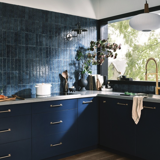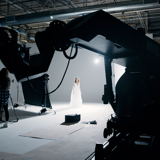A few weeks ago, the studio purchased a new Sony a7S II. We acquired it primarily as a second camera, supporting our Sony FS7 on video shoots. For years we’ve used our Canon 5D Mark III as the second video camera, as well as our primary still camera for locations. But, after 250,000-plus shutter cycles, the Canons are getting a little long in the tooth and our team of Cleveland photographers needed an upgrade.
Unsurprisingly, the new Sony sparked an interesting discussion: when we upgrade our Canon bodies, should we stick with Canon, or should we move to Sony? Any decision would have a direct impact on our clients, so we broke down exactly what each camera brought to the table to figure out which solution was the best for your future projects.
The Joys of the Lens Adapter
One of the cool things that has been returning to the photo scene over the last few years is the lens adapter. Because of some advances in technology and well thought out redesigns, this seemingly simple device has created a paradigm shift in the way we look at camera brands.
Basically, the lens adapter allows a cinematographer or photographer to pair different brands of cameras and lenses, opening the door to amazing combinations and adding yet one more level of creative control to the process. In fact, our Metabones adapter allowed us to purchase the FS7 instead of a lesser camera because we could use the Canon lenses we already owned. Simply put, money that would have gone to a complete camera/lens gear bag got spent solely on the camera. When you’re talking about the cost of professional quality video lenses, that afforded us - and you by extension - a big upgrade. With that in mind, we realized we could seriously consider a completely different brand of camera to replace our existing bodies. Enter Sony.
Sony vs. Canon
While we recognize the Sony brand as a solid, reliable electronics manufacturer, Sony has also been making cameras for years. They introduced their first digital camera in 1981, their first DSLR in 2006, and their first mirrorless option in 2010. Unsurprisingly, Sony produces some of the best CMOS sensors on the market today. Before we go all in with Sony, we’ve got to recognize how well Canon has served us over the years.
Canon entered the digital camera world in 1986 with a “professional still video camera.” In 1989, they brought out the first EOS-1, professional autofocus SLR. Until the EOS came along, autofocus (AF) was just a nice bell and whistle. Not too many pros relied upon it. After the EOS, AF became standard and expected. In 1996, Canon introduced its first consumer digital camera, and in 1998, it announced the XL1 — “The world’s first Mini DV camcorder with interchangeable lenses.”
In 2001, Canon delivered its first professional DSLR, the EOS-1D. And then, in 2008, the company broke down barriers with its EOS 5D Mark II. This camera added full HD video capabilities to an already strong, yet affordable platform of photo gear, effectively making high quality, HD video available to the everyman. Since then, the DSLR video market has blown up considerably.
So, what do Canon and Sony have to offer today? Well, Canon has a bevy of cameras under the 1D and 5D monikers. Some are geared for speed, while some are geared for resolution. Their latest 5D Mark IV brings the following list of specs:
-
30 megapixel full-frame CMOS sensor
-
4k video capability (24 and 30 fps)
-
61-point phase-detection AF with a dedicated sensor
-
ISO 32,000 (expandable to 102,400)
Sony, too, offers a curated collection of top end models under the a7 name: a7R II, a7S II, a7 II, a7R, a7S, and a7. The a7R II comes with these specs:
-
42 megapixel full-frame CMOS sensor
-
4k video capability (24 and 30 fps)
-
399-point phase-detection/25-point contrast-detection AF
-
ISO 25,600 (expandable to 102,400)
The a7S II delivers this list of specs:
-
12 megapixel full-frame CMOS sensor
-
4k video capability (24 and 30 fps)
-
169-point contrast-detection AF
-
ISO 102,400 (expandable to 409,600)
So, between these clearly capable cameras, where are the differences, and how do we decide which ones are best for us and our customers?
Choosing the Right Photography Equipment for Our Projects
The most obvious difference lies in their design. The Canon 5D is physically larger and has a mirror. The Sonys are mirrorless, and because of that, are about 3/4 the size of the Canon. While on the surface this seems like an advantage, in real world use it can prove otherwise. Photographers with larger hands have sometimes shied away from mirrorless cameras because the controls are difficult to manage due to the smaller platform. Also, mirrorless cameras use electronic viewfinders (EVFs) which constantly draw power and drastically limit the shooting time of the battery. On the plus side of EVFs, low-light shooting becomes much easier because the photographer no longer has to rely on available light. The brightness of the scene in the viewfinder is only limited by the camera’s ISO.
Another big consideration for us, and many other Canon (or Nikon) shooters, is the fact that we’ve already invested in a long list of Canon lenses. As I mentioned earlier, the Metabones adapter that came with our FS7 kit has made our Canon lenses compatible with the Sony cameras, but not all the functions carry through. The weakest link for us is the slowing (or total failure) of the AF with the adapter. Canon has developed a phenomenal AF system that we’ve grown to love and trust over the years. Losing that feature because of the adapter is almost incapacitating. We could purchase the Sony lenses to regain excellent AF, but that would be defeating the whole idea of adding another creative option by mixing brands without extra cost. Also, for twice the price, Metabones makes a Speed Booster version of its adapter that theoretically solves the lens communication issues. It also adds extra glass between the lens and sensor, so there’s still a trade-off.
Probably the biggest factor that has made the Canon v. Sony discussion serious is Sony’s video capability. When we purchased the Sony FS7, it definitely upped our game. Not only did it bring 4k video capability, but it also added a huge dynamic range and incredible low-light capability. Compared to the 5D Mark III, the Sony a7 series made the second camera decision a no-brainer. The a7S II brought great resolution at 4k and a phenomenally wide dynamic range to boot. It’s low-light capability isn’t too shabby either, but until we get our hands on the new 5D Mark IV, we won’t be able to truly compare it’s updated video capability. That being said, our clients have continued to demand more and more video production from us, so maybe there’s a place in our quiver for another Sony body. After all, in the 12th hour of working the Movi, a slightly lighter camera body is a refreshing thought.
The Right Camera Equipment (and Experts) for Your Commercial Photography Projects
As a multimedia studio, it’s essential that we have the right tools to capture stunning imagery. Of course, the success of your projects goes beyond the camera.
At TRG, we’ve not only invested in equipment to provide a range of multimedia capabilities, we also have a team in place that excels both technically and creatively. Our experts can capture your vision on camera and guide you through the photography process to ensure your project runs as smoothly as possible. Meanwhile, our video, CGI, and other capabilities allow you to bundle projects together for add even more bang to your buck.
Ready to start your next photography project? Contact us today to see how our investment in both people and technology can make your project a success.



